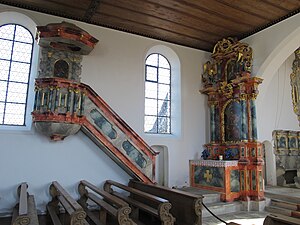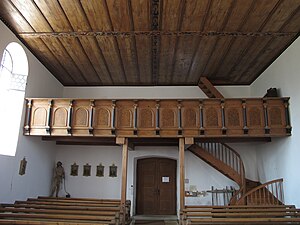Schöllang Castle Church
The castle church of St. Michael in Schöllang near Oberstdorf is the oldest Catholic parish church in the town.
history
The church is located on a wooded slate slope southwest of the town of Schöllang above the Illertal , which could have housed a cave sanctuary and later a Rhaetian hill fort in prehistoric times . The first written mention of the church uff dem Burgk comes from the year 1351; the current shape of the church should go back to the beginning of the 15th century. Parts of the building are even older; During the redesign, parts of the early medieval predecessor building were included on the north and west sides.
At Pentecost 1579 the roof structure and tower as well as three bells were destroyed by a lightning strike . Thanks to a donation from the Augsburg Bishop Marquard vom Berg , a bell cast by Hans Frei in Kempten could be acquired. This bell should originally have been heard as far as Kempten, but was muffled by numerous hammered nails so that it would not reveal the location of the church to the enemy in times of war. It hung in a bell house by the castle church until 1804 and was then transferred to the new parish church of the village. The bell bears the shoulder inscription GOT. COMPARISON . VNS. GRACE. MARQVART. FROM . Of GOD. MERCY. BISCHOVE. ZVE. AVGSPVRG. VND. THVMB. BROBST - ZVE BAMBERG. The foundry inscription reads: HANS FREI / ZVO KEMPTEN / HAT MICH GOSE. The bell is 1.02 meters high and 1.32 meters in diameter. It bears the date 1579 and is adorned with the coat of arms of the diocese of Augsburg as well as its founder and reliefs of the evangelist John and the coronation of Mary.
In 1580 the roof structure was rebuilt; a red inscription on the upper throat bar reads: The little kitchen is fused because it was built in 1579 and rebuilt in 1580. Two maker's marks have also been preserved. The originally Gothic windows were expanded to form arched windows in the 18th century; presumably windows were also broken in the previously windowless north wall. The church was extended in late Gothic style and widened to the south. It received a choir closed on three sides and a sacristy ; In addition, a wall with niches was added , probably for a Mount of Olives group . The roof turret with onion dome dates from 1837. Renovation work took place from 1969 to 1985. The roof covering with cedar shingles dates from 1969.
Until 1804 the castle church served as the parish church of the community Schöllang, after that only as a cemetery chapel .
Furnishing
At the west entrance there were once frescoes from the 15th century, which showed a court scene with Christ, Mary and Michael with the soul scales .
The altars of the church are from the high baroque period. The high altar shows the Archangel Michael as the namesake of the church during the fall of hell. The depiction dates from around 1680. The altar is flanked by wooden figures of Ignatius von Loyola and the martyr Johannes Nepomuk . The holy walk can be seen in the excerpt from the altar.
The side altars were designed in 1707 by Paul Zeiller from Reutte . The left altarpiece shows the Mother of God, Mary, who keeps the boy John standing in front of her from tickling the sleeping baby Jesus, in the excerpt the penitent Mary Magdalene can be seen. The right altarpiece shows Saint Joseph and in the excerpt you can see Antonius of Padua with the baby Jesus. The angels on the altars were made by the sculptor Ferdinand Ertinger from Kempten.
The church has an octagonal baptismal font from the time it was built. Above is a figural niche with Saints Rochus, James the Elder , Ignatius von Loyola and Sebastian as well as the diocese saints Ulrich and Afra. Mary Magdalene is shown again in the extract. These works date from around 1680.
A curiosity is a classicist tumba on which an Allgäu farmer in typical clothing lifts the sheet.
The pulpit dates from 1711; A priest's grave stone made of sandstone from the 16th century was incorporated.
The apostle crosses in the choir and on the north wall date from the late Gothic period. Under the gallery in the south-west corner stands a roughly life-size wooden figure of the man of pain in chains.
The church has a wooden ceiling that existed in a similar form before the fire in 1579. It shows stylized plant motifs in red, blue and black. The ceiling was renewed after the lightning strike and again in 1898.
An entrance on the south side of the nave was walled up and the outside was redesigned as a memorial and burial place for the Schöllang pastors. The developer of the Breitachklamm , Johannes B. Schiebel, is also buried here. The cemetery by the church is still used today by the communities of Schöllang, Rubi, Reichenbach, Au, Oberhalhofen and Unterthalhofen. Most of the graves are traditionally oriented to the east. Parts of the old surrounding wall made of rolling stones and broken stones with shingle cover have been preserved. Outside the cemetery south of the church is the only surviving Stations of the Cross from the 18th century.
organ
The organ was built by the organ builder Franz Fidelis Haaser (Stiefenhofen) in 1876. The instrument has 12 registers on a manual mechanism and pedal . The playing and stop actions are mechanical.
|
|
||||||||||||||||||||||||||||||||||||||||||||
- Coupling : I / P
literature
- Werner Schnell: Schöllang im Allgäu , Regensburg, 4th edition 2005, ISBN 3-7954-4772-0 , pp. 13-16
Individual evidence
- ^ Diocese of Augsburg
- ↑ Information on the organ: Christian Kohler: Orgeln und Organbauer im Allgäu from 1850 to the present . Diploma thesis 2007, Musikhochschule Augsburg / Nürnberg.
Web links
Coordinates: 47 ° 27 ′ 7.6 ″ N , 10 ° 17 ′ 0.9 ″ E










